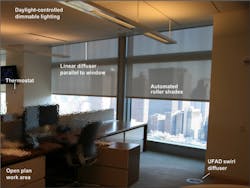The combination of autonomous SSL and shading in a New York high rise office space has yielded 80% energy savings in some cases while also pleasing workers.
The US Department of Energy (DOE) Lawrence Berkeley National Laboratory (Berkeley Lab) has detailed a living laboratory test of solid-state lighting (SSL) and controls on a 40,000-ft2 floor in a New York commercial office building. Berkeley Lab worked with the Building Energy Exchange (BEEx) on the LED lighting project that also included comprehensive light and occupancy sensors along with connected window shade controls. Berkeley Lab believes the work will speed market adoption of smart lighting and the BEEx will use the work to further its educational mission, serving lighting designers and specifiers that are working on commercial spaces.
Interested in articles & announcements on smart lighting & IoT?
Lately, much of our coverage about smart lighting and the Internet of Things (IoT) has been focused on what lighting-based connectivity can offer in supporting new applications and services such as indoor positioning, security, asset tracking, and more. For example, Acuity Brands said earlier this year that it has deployed indoor positioning technology in 20 million ft2 of retail space. The IoT hype can make it easy to forget that networked control of lighting and shades confined to a space such as an office floor can deliver tremendous benefits in energy used.
Still, roadblocks to more smart lighting installations remain. “Context matters when it comes to figuring out where the market barriers are with respect to contractors, facility managers, and office workers — isolated tests in a laboratory environment are often not enough,” said Eleanor Lee. “Reducing stakeholders’ uncertainty about performance and occupant response in a real-world setting can be critical to accelerating market adoption.” Lee is the Berkeley Lab scientist that led the New York project intended to document the benefits of smart lighting in a working office space — thus the characterization as a living lab.
Berkeley Lab and BEEx collaborated on an office smart lighting trial in New York City that combined SSL with sensors and window shade controls.
Indeed, the project team monitored energy usage and other characteristics of the office space for a full year before the retrofit to SSL and controls took place. BEEx acted as the local manager of the project.
As the nearby photo illustrates, the retrofit replaced fluorescent T5 lighting with dimmable LED fixtures delivering direct and indirect lighting. The floor-to-ceiling windows received automated shades. And connected sensors spread throughout the mostly-open space can detect localized light levels and occupancy.
The test further considered thermal elements of the space given that the ubiquitous windows and daylight can heat a space. The test included the use of linear slot diffusers along the top of the windows that can mitigate rising temperatures. And underfloor air distribution (UFAD) diffusers were used to improve airflow and allow for localized control. Thermal imaging was used to document acceptable temperatures throughout the retrofitted space.
The smart lighting project sought to balance the benefits of natural light with visual and thermal comfort and provide workers with enjoyable views when possible. Shades had to be lowered at times to mitigate glare but could be opened at other times, both reducing the need for artificial lighting and fully revealing views for the office.
The study focused on the 40-ft perimeter zone of the office floor. Compared to the measured baseline, the electricity required for lighting dropped 79% over the course of six months in which BEEx has monitored the installation. Peak electrical demand dropped 74%.
The study did not measure energy dedicated to powering the HVAC (heating, ventilation, and air conditioning) system in the space. But the researchers did estimate the impact on HVAC energy and also projected the measured data to suggest an entire building retrofit would have delivered savings of $730,000 per year. Based on installation cost of $3–$10 per square foot, an entire building project would pay back in 3–12 years.
BEEx will take the results of the project to help the lighting community with tools and other resources. “Using everything we learned on this project, we’ve developed a series of tools that will really help the engaged design professional or building owner make better decisions about lighting system upgrades, and avoid the common pitfalls on the road to a high-performance office space,” said Yetsuh Frank, BEEx managing director of strategy and programs.
The Berkeley Lab has not been as involved in the SSL sector as has the DOE Pacific Northwest National Laboratory (PNNL). PNNL has been behind many of the DOE Caliper and Gateway projects. We have covered many of those reports such as a recent Gateway report on four common indoor lighting applications.
Still, the Berkeley Lab is adding to the DOE’s SSL initiative. About a year back we reported on a Berkeley project involving solar-powered LED lighting outdoors where the researchers said such lighting could create 2 million jobs in developing regions.






